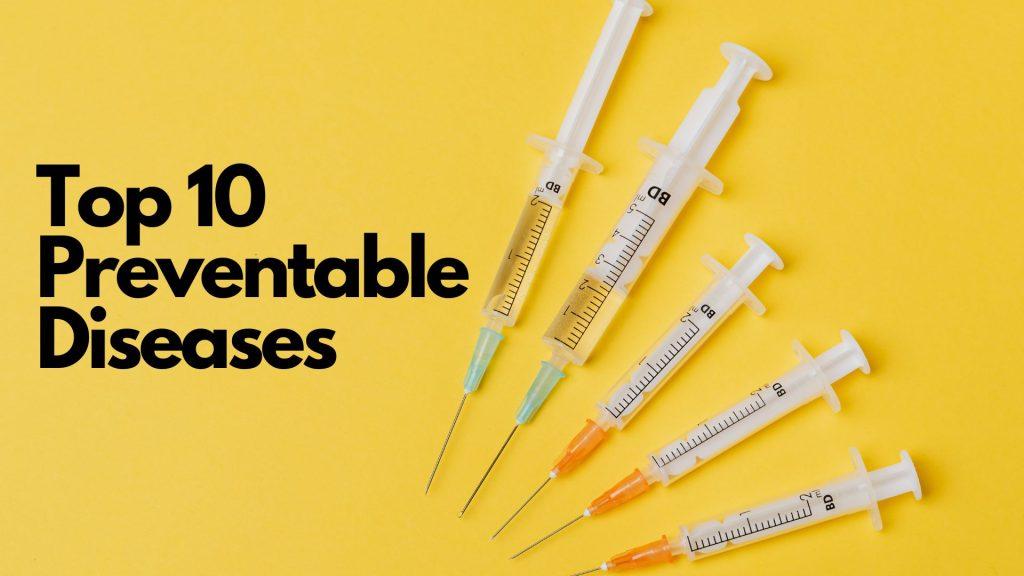
Preventable diseases are diseases that can be prevented or controlled through lifestyle changes, early detection and diagnosis, and medical treatment. Today, many common diseases are the result of an unhealthy diet, lack of exercise, and harmful habits. The good news is that you can make simple changes to your lifestyle that significantly reduce your risk and allow you to live a healthier life.
So in this blog, we will discuss the top 10 preventable diseases and how to protect yourself.
Heart Disease
What Is It?
Heart disease consists of things like heart attacks, high blood pressure, and stroke. It’s among the leading causes of death around the world.
How to Reduce Risk:
Follow a heart-healthy diet, full of fruits, vegetables and whole grains.
Take regular exercise to improve circulation and maintain a healthy weight.
Do not smoke and do not drink too much alcohol.
Use relaxation techniques, such as meditation or yoga, to manage stress.
Get your blood pressure and cholesterol checked regularly.
Diabetes
What Is It?
Diabetes happens when the body does not use insulin properly, which causes high blood sugar.
How to Reduce Risk:
Follow a low sugar and high fiber diet.
Implement regular exercise to improve insulin sensitivity
Be at a healthy weight in order to avoid insulin resistance.
Reduce intake of sugar-sweetened beverages and processed foods.
Regular check-ups of blood sugar level.
Obesity
What Is It?
Obesity is excess body fat. It increases the risk of other diseases, including heart disease and diabetes.
How to Reduce Risk:
All you need to do is eat healthy food and stay away from junk food which is high on calories.
Get Daily Workout Activities To Stay Active
Watch portion sizes and eat mindfully.
You should not drink sugary drinks and drink a lot of water.
Sufficient sleep to efficient metabolism.
Lung Disease
What Is It?
Chronic lung diseases such as asthma and chronic obstructive pulmonary disease (COPD) result in difficulty breathing.
How to Reduce Risk:
Do not smoke or be around secondhand smoke.
In polluted areas, wear a mask to protect your lungs.
Be active to maintain lung works.
If your breathing is affected, have regular lung function tests.
Stay away from toxic chemicals you may encounter at work
Stroke
What Is It?
A stroke occurs when bleeding blocks blood flow to the brain, causing brain damage.
How to Reduce Risk:
Manage blood pressure.
Follow a healthy diet that includes a lot of fruit and vegetables and is low in salt and unhealthy fats.
Get daily exercise to increase circulation.
Don’t smoke because that will increase the risk of stroke.
Stay healthy through stress management.
Cancer
What Is It?
Cancer is the unrestricted growth of abnormal cells in the body. Certain types, such as lung and it, are preventable.
How to Reduce Risk:
If you smoke, stop, and limit alcohol.
That would be foods high in antioxidants, such as berries and leafy greens.
Wear sunscreen to avoid overexposing your skin to sunlight.
So get regularly screened to catch it early.
Keep moving for immune function
Liver Disease
What Is It?
Alcohol use and poor diet can lead to liver disease, fatty liver and cirrhosis.
How to Reduce Risk:
Limit alcohol consumption.
Eat a diet variable in vegetables and lean proteins.
Drink water rather than sugary beverages.
Stay away from processed foods and too much sugar.
Preventing hepatitis, get vaccinated.
Kidney Disease
What Is It?
Kidney disease can progress to kidney failure and the need for dialysis or a transplant.
How to Reduce Risk:
Drink plenty of water to cleanse toxins.
Restrict sodium consumption to preserve kidney functionality.
Keep blood pressure and diabetes in check.
Consume kidney-supporting foods, such as berries and fish.
Do not overuse painkillers.
Osteoporosis
What Is It?
Osteoporosis causes bones to become weak and brittle, increasing the risk of breaks.
How to Reduce Risk:
Get more calcium from dairy or green leafy vegetables.
Make sure you are getting enough vitamin D through either sunlight or supplements.
Participate in weight-bearing activities such as walking or weight training.
Cut back on alcohol and caffeine, which deplete bones.
Steer clear of smoking to maintain bone density.
Depression and Anxiety
What Is It?
Common mental health disorders can translate into poor daily functioning and a higher risk of other conditions.
How to Reduce Risk:
Maintain social connections with family and friends.
Move regularly to help your mood.
Learn mindfulness, yoga, and stress-reducing skills.
If necessary, seek help from a professional.
Get a healthy work-life balance.
Conclusion
With the right lifestyle choices, many serious diseases can be prevented. Eating well, remaining active and having regular check-ups can help keep your risk much reduced. With small tweaks here and there, a longer and healthier life is possible.
Questions And Answers
What is the most avoidable disease?
Disease, with diet and exercise, is one of the most aggressive preventable disease known.
Do lifestyle changes actually stop disease from happening?
Yes! Proper diet, exercise, and avoiding bad habits do greatly reduce disease risk.
How often you should have a check-up?
Once a year for general screenings, more often if you have risk factors.
Can drinking water prevent diseases?
Yes, being hydrated helps the kidneys, digestion — and the whole body.
Who could I be to make my health better today?
Start with small steps such as eating more vegetables, drinking more water, moving your body more and reducing stress.
